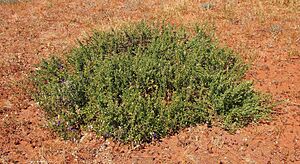MacDonnell's desert fuchsia facts for kids
Quick facts for kids MacDonnell's desert fuchsia |
|
|---|---|
 |
|
| Eremophila macdonnellii flowers | |
| Scientific classification | |
| Genus: |
Eremophila (plant)
|
| Species: |
macdonnellii
|
| Synonyms | |
|
List
|
|
The Eremophila macdonnellii, also known as MacDonnell's desert fuchsia, is a beautiful flowering plant found in Australia. It belongs to the figwort family. This plant is a shrub with many branches that often look tangled. Its branches and leaves are usually covered with tiny hairs. The flowers are a deep violet or purple color. You can find this plant growing in many parts of Central Australia.
Contents
What Does It Look Like?
MacDonnell's desert fuchsia is a round-shaped shrub. It has many tangled branches. It usually grows to be about 0.3 to 1.2 meters (1 to 4 feet) tall. It can spread out from 0.2 to 1.5 meters (0.7 to 5 feet) wide.
Branches and Leaves
The branches of this plant are covered with hairs. Some of these hairs can be as long as 3 millimeters (about 0.1 inches). The leaves grow one after another along the branches. They can be long and thin or shaped like an egg. Sometimes, they are even curved like a sickle. Most leaves are about 9 to 27 millimeters (0.4 to 1.1 inches) long. They are also about 2 to 5.5 millimeters (0.08 to 0.2 inches) wide. The leaves can be smooth or very hairy, sometimes with long hairs like those on the branches.
Flowers and Fruit
The flowers grow one by one where the leaves meet the branches. Each flower has a hairy stalk that is usually 4 to 26 millimeters (0.2 to 1 inch) long. The sepals, which are like small leaves protecting the flower bud, are joined together. They form a bell-shaped tube that is 6 to 9 millimeters (0.2 to 0.4 inches) long.
The petals, which are the colorful parts of the flower, are mostly 27 to 38 millimeters (1.1 to 1.5 inches) long. They are joined at the bottom to form a tube. The outside of this tube is usually a deep reddish-violet or purple. Sometimes, it can be pink or white. The inside of the tube is white with small violet spots. The outside of the petal tube is smooth and shiny. However, the inside of the tube is full of long, soft hairs. There are four stamens (the parts that make pollen) hidden inside the petal tube.
This plant mainly flowers between May and October. After the flowers, it produces fruits. These fruits are dry and shaped like an oval or almost round. They have a hairy, papery covering. The fruits are usually 9 to 15.5 millimeters (0.4 to 0.6 inches) long.
Where Does It Grow?
MacDonnell's desert fuchsia is found across a wide area in Australia. You can see it in the southern part of the Northern Territory. It also grows in northern South Australia and the far south-western part of Queensland.
This plant usually grows on sand dunes or flat sandy areas. It often grows near Mulga woodlands, which are areas with many mulga trees.
Growing This Plant in Your Garden
MacDonnell's desert fuchsia is a great plant for gardens. It has attractive dark blue to purple flowers. These flowers are easy to see and are almost always present when the weather is good.
You can grow new plants from cuttings (small pieces of the plant). You can also grow them by grafting, which means joining a piece of this plant onto the roots of another plant called Myoporum. Grafted plants often live longer. They can also grow well in more types of soil.
This plant is quite tough and easy to care for. It's good for gardens that don't need much work. It can handle dry weather and is fairly resistant to frost. It also grows well in alkaline soils, even on its own roots. However, in places with a lot of humidity, it can sometimes get a type of mold called Botrytis. Its branches can be a bit fragile and might break in strong winds. But don't worry, the shrub usually grows back quickly during the growing season.



